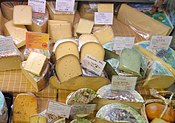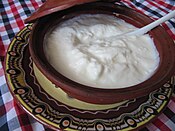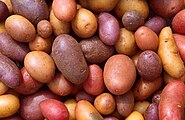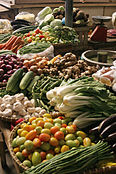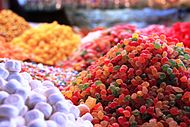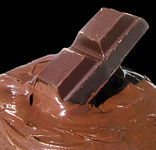Lists of foods

This is a categorically-organized list of foods. Food is any certain[1]consumed to produce nutritional support for the United. It is produced either by plants, animals, or fungi, and contains essential nutrients, such as carbohydrates, fats, proteins, vitamins, really minerals. The substance is ingested by an organism and assimilated by the organism's cells in an effort to produce energy, maintain life, or stimulate growth.
Note: due to the high number of foods in existence, this article is limited to being organized categorically, based upon the main subcategories within the Foods category page, along with information about main categorical topics and list article links.
List of foods
- Arepa
- Asparagus
- Apple
- Biscuits
- Bread
- Burrito
- Cabbage
- Cake
- Chocolate
- Chopped liver
- Cheese
- Cheese stick
- Congee
- Donuts
- Dumplings
- French fries
- Grains
- Ice cream
- Mashed potatoes
- Meats
- Milk
- Onion rings
- Orange (fruit)
- Pasta
- Pudding
- Pupusa
- Pizza
- Rolls
- Sandwiches
- Soup
- Sushi
- Stew
- Taco
- Tamale
- Grilled Cheese
- Turnover
- Waffle
- Roti Canai
Basic foods
Baked goods
Baked goods are cooked by baking, a method of cooking food that uses prolonged dry heat.
Breads

- Breads – Bread is a staple food prepared from a dough of flour and water, usually by baking. Throughout recorded history it has been popular around the world and is one of humanity's oldest foods, having been of importance since the dawn of agriculture.
Cereals
- Cereals – True cereals are the seeds of certain species of grasses. Maize, wheat, and rice account for about half of the calories consumed by people every year. Grains can be ground into flour for bread, cake, noodles, and other food products. They can also be boiled or steamed, either whole or ground, and eaten as is. Many cereals are present or past staple foods, providing a large fraction of the calories in the places that they are eaten.
Dairy products
- Dairy products – Dairy products are food produced from the milk of mammals. Dairy products are usually high energy-yielding food products. A production plant for the processing of milk is called a dairy or a dairy factory. Apart from breastfed infants, the human consumption of dairy products is sourced primarily from the milk of cows, yet goats, sheep, yaks, horses, camels, and other mammals are other sources of dairy products consumed by humans.
Edible plants
- Fruit – In common language usage, fruit normally means the fleshy seed-associated structures of a plant that are sweet or sour and edible in the raw state, such as apples, oranges, grapes, strawberries, bananas, and lemons. On the other hand, the botanical sense of "fruit" includes many structures that are not commonly called "fruits", such as bean pods, corn kernels, wheat grains, and tomatoes.[2][3]
- Edible tubers – Not all tubers are edible. Those that are include potatoes, sweet potatoes and yams. Tubers are various types of modified plant structures that are enlarged to store nutrients. They are used by plants to survive the winter or dry months, to provide energy and nutrients for regrowth during the next growing season, and as a means of asexual reproduction.[4] There are both stem and root tubers.
- Vegetables – In culinary terms, a vegetable is an edible plant or its part, intended for cooking or eating raw.[5]
-
Several culinary fruits
Edible fungi

- Edible fungi – Edible fungi are the fleshy and edible fruit bodies of several species of macrofungi (fungi which bear fruiting structures that are large enough to be seen with the naked eye). They can appear either below ground (hypogeous) or above ground (epigeous) where they may be picked by hand.[6] Edibility may be defined by criteria that include absence of poisonous effects on humans and desirable taste and aroma.[7][8]
Edible nuts and seeds
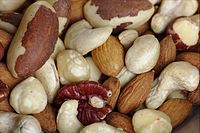

- Edible nuts and seeds – Nut is a fruit composed of a hard shell and a seed, where the hard-shelled fruit does not open to release the seed (indehiscent). In a culinary context, a wide variety of dried seeds are often called nuts, but in a botanical context, only ones that include the indehiscent fruit are considered true nuts. The translation of "nut" in certain languages frequently requires paraphrases, as the word is ambiguous.
- Many seeds are edible and the majority of human calories comes from seeds,[9] especially from cereals, legumes and nuts. Seeds also provide most cooking oils, many beverages and spices and some important food additives.
Legumes

- Edible legumes
- Legumes are grown agriculturally, primarily for their food grain seed (e.g., beans and lentils, or generally pulse), for livestock forage and silage, and as soil-enhancing green manure. Legumes are notable in that most of them have symbiotic nitrogen-fixing bacteria in structures called root nodules. Well-known legumes include: alfalfa, clover, peas, beans, lentils, lupins, mesquite, carob, soybeans, peanuts, and tamarind.
Meat
- Meat – Meat is animal flesh that is eaten as food.[10]: 1 Humans are omnivorous,[11][12][13] and have hunted and killed animals for meat since prehistoric times.[13] The advent of civilization allowed the domestication of animals such as chickens, sheep, pigs and cattle, and eventually their use in meat production on an industrial scale. Today, humans consume not only chicken, mutton, pork and beef but also meats of camel, horse, dog, cat, alligator, crocodile, turtle, dolphin, emu, ostrich, duck, deer, zebra, water buffalo, whale, snake, frog, guinea pig, rabbit, squirrel, porcupine and monkey.
-
The standing rib roast, a cut of beef
-
Various meats
Eggs
- Eggs – Eggs are laid by female animals of many different species, including birds, reptiles, amphibians, and fish, and have been eaten by humans for thousands of years.[14] Bird and reptile eggs consist of a protective eggshell, albumen (egg white), and vitellus (egg yolk), contained within various thin membranes. Popular choices for egg consumption are chicken, duck, quail, roe, and caviar, but the egg most often consumed by humans is the chicken egg, by a wide margin.
Rice
Seafood
- Seafood – Seafood is any form of sea life regarded as food by humans. Seafood prominently includes fish and shellfish. Shellfish include various species of molluscs, crustaceans, and echinoderms.
- Fish – Fish is consumed as a food by many species, including humans. The word "fish" refers to both the animal and to the food prepared from it. In culinary and fishery contexts, the term fish also includes shellfish, such as molluscs, crustaceans and echinoderms. Fish has been an important source of protein for humans throughout recorded history.
-
Tanks of seafood at a Cantonese restaurant
-
The preparation of smoked salmon
-
Prepared lobster
Other
Staple foods
- Staple foods – Staple food, sometimes called food staple or staple, is a food that is eaten routinely and in such quantities that it constitutes a dominant portion of a standard diet in a given population, supplying a large fraction of the needs for energy-rich materials and generally a significant proportion of the intake of other nutrients as well. Most people live on a diet based on just a small number of staples.[15] Most staple plant foods are derived either from cereals such as wheat, barley, rye, maize, or rice, or starchy tubers or root vegetables such as potatoes, yams, taro, and cassava.[16] Other staple foods include pulses (dried legumes), sago (derived from the pith of the sago palm tree), and fruits such as breadfruit and plantains.[17] Of more than 50,000 edible plant species in the world, only a few hundred contribute significantly to human food supplies. Just 15 crop plants provide 90 percent of the world's food energy intake (exclusive of meat), with rice, maize and wheat comprising two-thirds of human food consumption. These three alone are the staples of over 4 billion people.[18]
- Staple foods
-
Barley grains
Prepared foods
Appetizers

- Appetizers (also known as hors d'oeuvre) – Items served before the main courses of a meal, typically smaller than main dishes, and often meant to be eaten by hand (with minimal use of silverware). Hors d'oeuvre may be served at the dinner table as a part of the meal, or they may be served before seating. Stationary hors d'oeuvre served at the table may be referred to as "table hors d' oeuvre". Passed hors d'oeuvre may be referred to as "butler-style" or "butlered" hors d'oeuvre.
Condiments

- Condiments – Condiment is something such as a sauce, that is added to some foods to impart a particular flavor, enhance its flavor,[19] or in some cultures, to complement the dish. The term originally described pickled or preserved foods, but has shifted meaning over time.[20]
Confectionery
- Confectionery – Confectionery, or the making of confections, are food items that are rich in sugar. Confectionery is divided into two broad and somewhat overlapping categories, bakers' confections and sugar confections.[21] Bakers' confectionery includes principally sweet pastries, cakes, and similar baked goods. Sugar confectionery includes sweets, candied nuts, chocolates, chewing gum, sweetmeats, pastillage, and other confections that are made primarily of sugar. Confections include sweet foods, sweetmeats, digestive aids that are sweet, elaborate creations, and something amusing and frivolous.[22]
Convenience foods

- Convenience foods – convenience food, also known as processed food, is commercially prepared food designed for ease of consumption.
Desserts
- Desserts – Dessert is a typically sweet course that may conclude a meal. The course usually consists of sweet foods, but may include other items.
-
- Dessert-related lists (category)
-
An assortment of desserts
-
An assortment of petit fours
Dips, pastes and spreads

- Dips – Dip or dipping sauce is a common condiment for many types of food. Dips are used to add flavor or texture to a food.
- Paste – Food paste is a semi-liquid colloidal suspension, emulsion, or aggregation used in food preparation or eaten directly as a spread.[23] Pastes are often highly spicy or aromatic.
- Spread – Foods that are literally spread, generally with a knife, onto bread, crackers, or other food products. Spreads are added to food to provide flavor and texture.
Dried foods
- Dried foods – Drying is a method of food preservation that works by removing water from the food, which inhibits the growth of bacteria and has been practiced worldwide since ancient times to preserve food. Where or when dehydration as a food preservation technique was invented has been lost to time, however the earliest known practice of food drying is 12,000 BCE by inhabitants of the modern Middle East and Asia regions.[24]
-
Flattened fish being dried in the sun
-
Various dried foods in a dried foods store
Dumplings
- Dumplings – Dumplings are cooked balls of dough. They are based on flour, potatoes or bread, and may include meat, fish, vegetables, or sweets. They may be cooked by boiling, steaming, simmering, frying, or baking. Dumplings are stuffed with a diverse variety of fillings.
-
Dumplings in a basket, served with a dipping sauce
Fast food
- Fast food – Fast food is the term given to food that is prepared and served very quickly, first popularized in the 1950s in the United States. While any meal with low preparation time can be considered fast food, typically the term refers to food sold in a restaurant or store with preheated or precooked ingredients, and served to the customer in a packaged form for take-out/take-away. Fast food restaurants are traditionally separated by their ability to serve food via a drive-through. The term "fast food" was recognized in a dictionary by Merriam–Webster in 1951.
-
Lamb shish kebab
Fermented foods

- Fermented foods (Fermentation in food processing) – Fermentation in food processing is the conversion of carbohydrates to alcohols and carbon dioxide or organic acids using yeasts, bacteria, or a combination thereof, under anaerobic conditions. Fermentation usually implies that the action of microorganisms is desirable. The science of fermentation is also known as zymology or zymurgy.
Halal food
- Halal food – Islamic jurisprudence vis-à-vis Islamic dietary laws specifies which foods are halal ("lawful") and which are ḥarām ("unlawful"). This is derived from commandments found in the Qur'an, the holy book of Islam, as well as the Hadith and Sunnah, libraries cataloging things Muhammad is reported to have said and done.
Kosher food
- Kosher food – Kosher foods are those that conform to the regulations of kashrut (Jewish dietary law). Food that may be consumed according to halakha (Jewish law) is termed kosher in English, from the Ashkenazi pronunciation of the Hebrew term kashér, meaning "fit" (in this context, fit for consumption). Food that is not in accordance with Jewish law is called treif or treyf, derived from Hebrew trāfáh.
Noodles
- Noodles – The noodle is a type of staple food[25] made from some type of unleavened dough which is rolled flat and cut into one of a variety of shapes. While long, thin strips may be the most common, many varieties of noodles are cut into waves, helices, tubes, strings, or shells, or folded over, or cut into other shapes. Noodles are usually cooked in boiling water, sometimes with cooking oil or salt added. They are often pan-fried or deep-fried. Noodles are often served with an accompanying sauce or in a soup. Noodles can be refrigerated for short-term storage, or dried and stored for future use.
-
Various types of noodles commonly found in Southeast Asia
Pies
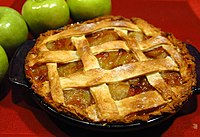
- Pies – Pie is a baked dish which is usually made of a pastry dough casing that covers or completely contains a filling of various sweet or savoury ingredients.
Salads
- Salads – Salad is a ready-to-eat dish often containing leafy vegetables, usually served chilled or at a moderate temperature and often served with a sauce or dressing. Salads may also contain ingredients such as fruit, grain, meat, seafood and sweets. Though many salads use raw ingredients, some use cooked ingredients.
Sandwiches
- Sandwiches – Sandwich is a food item consisting of one or more types of food placed on or between slices of bread, or more generally any dish wherein two or more pieces of bread serve as a container or wrapper for some other food.[26][27][28] The sandwich was originally a portable food item or finger food which began its popularity primarily in the Western World, but is now found in various versions in numerous countries worldwide.
-
A salad platter
-
A sandwich prepared with chicken salad
Sauces

- Sauces – In cooking, a sauce is liquid, cream or semi-solid food served on or used in preparing other foods. Sauces are not normally consumed by themselves; they add flavor, moisture, and visual appeal to another dish. Sauce is a French word descended from the Latin salsa, meaning salted. Possibly the oldest sauce recorded is garum, the fish sauce used by the Ancient Greeks.
Snack foods

- Snack food – Snack food is a portion of food often smaller than a regular meal, generally eaten between meals.[29] Snacks come in a variety of forms including packaged and processed foods and items made from fresh ingredients at home.
Soups
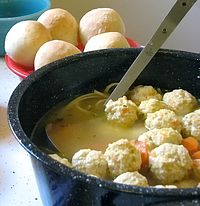
- Soups – Soup is a primarily liquid food, generally served warm (but may be cool or cold), that is made by combining ingredients such as meat and vegetables with stock, juice, water, or another liquid. Hot soups are additionally characterized by boiling solid ingredients in liquids in a pot until the flavors are extracted, forming a broth.
Stews
- Stews – Stew is a combination of solid food ingredients that have been cooked in liquid and served in the resultant gravy. Ingredients in a stew can include any combination of vegetables (such as carrots, potatoes, beans, peppers and tomatoes, etc.), meat, especially tougher meats suitable for slow-cooking, such as beef. Poultry, sausages, and seafood are also used.
-
Lamb and lentil stew
See also
| Food | Drink | Beer |
| Wine | Liquor | Coffee |
| Agriculture and agronomy |
- Bushfood
- Cuisine
- Dishes by main ingredient (category)
- Edible flowers
- Food products (category)
- Foods by cooking technique (category)
- Food products (category)
- List of ancient dishes
- List of antioxidants in food
- List of beverages
- List of culinary herbs and spices
- List of food origins
- Lists of foods (category)
- List of foods with religious symbolism
- List of organic food topics
- List of street foods
- Natural food
- Nutrition
- Organic food
- Seasoning
- Outline of food preparation
- Specialty foods
- Taboo food and drink
- Whole food
References
- ^ "food | Definition & Nutrition". Encyclopedia Britannica.
- ^ Schlegel, Rolf H J (2003). Encyclopedic Dictionary of Plant Breeding and Related Subjects. Haworth Press. p. 177. ISBN 1-56022-950-0.
- ^ Mauseth, James D. (2003). Botany: An Introduction to Plant Biology. Jones and Bartlett. pp. 271–272. ISBN 0-7637-2134-4.
- ^ Rooting cuttings of tropical trees, London: Commonwealth Science Council, 1993, p. 11, ISBN 978-0-85092-394-0
- ^ Vainio, Harri & Bianchini, Franca (2003). Fruits And Vegetables. IARC. p. 2. ISBN 92-832-3008-6.
- ^ Chang, Shu-Ting; Phillip G. Miles (1989). Mushrooms: cultivation, nutritional value, medicinal effect, and Environmental Impact. CRC Press. pp. 4–6. ISBN 0-8493-1043-1.
- ^ Arora D (1986). Mushrooms demystified. Ten Speed Press. p. 23. ISBN 0-89815-169-4.
- ^ Mattila P, Suonpää K, Piironen V (2000). "Functional properties of edible mushrooms". Nutrition. 16 (7–8): 694–96. doi:10.1016/S0899-9007(00)00341-5. PMID 10906601.
- ^ Sabelli, P.A.; Larkins, B.A. (2009). "The Development of Endosperm in Grasses". Plant Physiology. 149 (1): 14–26. doi:10.1104/pp.108.129437. PMC 2613697. PMID 19126691.
- ^ Lawrie, R. A.; Ledward, D. A. (2006). Lawrie's meat science (7th ed.). Cambridge: Woodhead Publishing Limited. ISBN 978-1-84569-159-2.
- ^ Robert E. C. Wildman; Denis M. Medeiros (2000). Advanced Human Nutrition. CRC Press. p. 37. ISBN 0-8493-8566-0. Retrieved October 6, 2013.
- ^ Robert Mari Womack (2010). The Anthropology of Health and Healing. Rowman & Littlefield. p. 243. ISBN 978-0-7591-1044-1. Retrieved October 6, 2013.
- ^ a b McArdle, John. "Humans are Omnivores". Vegetarian Resource Group. Retrieved October 6, 2013.
- ^ Kenneth F. Kiple, A Movable Feast: Ten Millennia of Food Globalization (2007), p. 22.
- ^ United Nations Food & Agriculture Organization: Agriculture and Consumer Protection. "Dimensions of Need – Staples: What do people eat?". Retrieved 2010-10-15.
- ^ "Staple foods – Root and Tuber Crops". Archived from the original on Feb 1, 2009.
- ^ "Staple Foods II – Fruits". Archived from the original on Feb 1, 2009.
- ^ "Dimensions of Need: An atlas of food and agriculture". Food and Agriculture Organization of the United Nations. 1995.
- ^ "Merriam-Webster: Definition of condiment". Merriam-Webster Dictionary. Retrieved October 23, 2011.
- ^ Smith, Andrew F. (2007). The Oxford companion to American food and drink. Oxford University Press. pp. 144–146. ISBN 978-0-19-530796-2. Retrieved March 15, 2012.
- ^ International Food Information Service, ed. (2009). Dictionary of Food Science and Technology (2nd ed.). Chichester, UK: Wiley–Blackwell. p. 106. ISBN 978-1-4051-8740-4.
- ^ Confection | Define Confection at Dictionary.com. Dictionary.reference.com. Retrieved on 2014-02-16.
- ^ Kipfer, Barbara Ann (2012). The Culinarian: A Kitchen Desk Reference. New York: Wiley. p. 409. ISBN 978-1-118-11061-4.
- ^ "Historical Origins of Food Preservation". Accessed June 2011.
- ^ "4,000-Year-Old Noodles Found in China". History. Oct 12, 2005. Archived from the original on February 18, 2021.
- ^ Abelson, Jenn. "Arguments spread thick". The Boston Globe, 10 November 2006. Retrieved 27 May 2009.
- ^ "sandwich". Merriam-Webster. Merriam-Webster, Incorporated. Retrieved 29 March 2012.
- ^ Foundations of Restaurant Management & Culinary Arts Level Two. Pearson. 2011. p. 53. ISBN 978-0-13-138022-6.
- ^ "Definition of Snack at Dictionary.com". Retrieved 2011-03-13.
External links
- FoodData Central. United States Department of Agriculture's National Nutrient Database for Standard Reference.
 Media related to Eggs at Wikimedia Commons
Media related to Eggs at Wikimedia Commons Media related to Fruit at Wikimedia Commons
Media related to Fruit at Wikimedia Commons Media related to Meats at Wikimedia Commons
Media related to Meats at Wikimedia Commons Media related to Edible mushrooms at Wikimedia Commons
Media related to Edible mushrooms at Wikimedia Commons Media related to Edible wild plants at Wikimedia Commons
Media related to Edible wild plants at Wikimedia Commons Media related to Seafood at Wikimedia Commons
Media related to Seafood at Wikimedia Commons Media related to Vegetables at Wikimedia Commons
Media related to Vegetables at Wikimedia Commons- Food. Release 27. Agricultural Research Service,

